PRINCETON, NJ -- A new Gallup analysis of almost 150,000 interviews conducted from January through May of this year sheds new light on the substantial gender gap that exists in American politics today. Not only are women significantly more likely than men to identify as Democrats, and less likely to identify as independents, but -- with only slight variation -- this gap is evident across all ages, from 18 to 85, and within all major racial, ethnic, and marital-status segments of society.
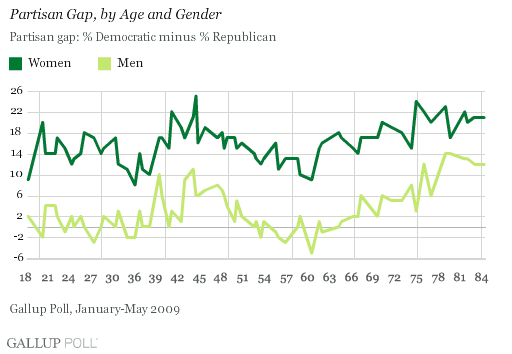
A recent Gallup analysis confirmed the existence of a fundamental gender gap in American political party identification today, although the exact nature of that gap has varied over recent years. The major distinction in political party identification today seems to revolve around the percentage of each gender who identify as Democrats versus independents; men and women have been similar in terms of identification with the Republican Party this year.
In the current analysis of 149,192 Gallup Poll Daily tracking interviews conducted in January through May of this year, 41% of women identify as Democrats, some nine points higher than the 32% of men who identify as Democrats. The 34% of men in this sample who are independents can be contrasted with the smaller 26% of women who are independents. There is little difference by gender in terms of identification as Republicans -- 28% of men are Republicans, compared to 25% of women.
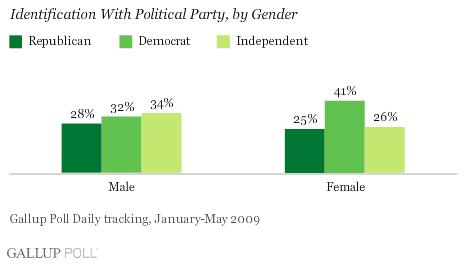
Overall, the data confirm that men currently have a much more even distribution of party identification than do women. The range across the three partisan groups for men is just 6 points, from a low of 28% identifying as Republicans to a high of 34% identifying as independents. On the other hand, the range for women is a much larger 16 points, from 25% Republican to 41% Democratic.
The Age Factor
Previous Gallup research has shown significant variations in party identification across age groups in the American population. Baby boomers (aged 45-63) are more likely than average to identify as Democrats, as are younger Americans in Generation Y (aged 18-29), while Generation X (aged 30-44) as well as older Americans are somewhat more Republican in orientation. The new Gallup analysis, importantly, shows the persistence of a gender gap not only within each of these broad age groups, but at every age, from 18 to 85, even as the overall party identification patterns shift across the age spectrum.
The accompanying chart displays the "partisan gap" for men and for women at each age. The broad trends certainly document the fact that the Democratic over Republican advantage varies across age groups. Democrats have their greatest advantage among baby boomers and the very young, and are weakest, relatively speaking, among those in their late 30s and in their mid- to late 60s. The key point for the current analysis, however, is that these variations occur among both men and women. There is, as noted, a gender gap in this partisan orientation measure at every age point, from 18 to 85.
Three additional charts display the gender differences in the percentages identifying as Republicans, independents, and Democrats across all age groups. The gender gap is largest in terms of Democratic and independent identification, and smallest for the percentage identifying as Republicans, but for the most part, a gender gap exists for every age in terms for each of these three partisan groups.
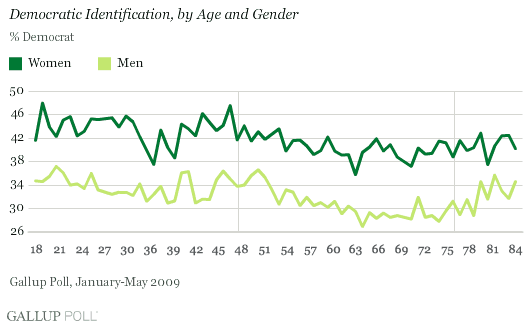
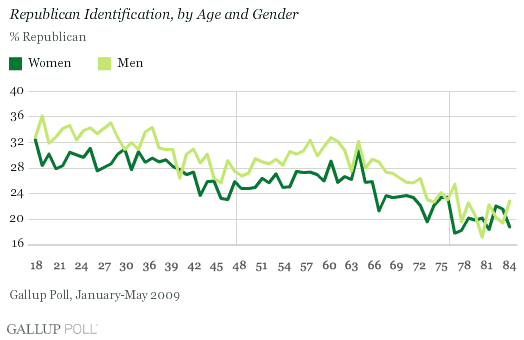
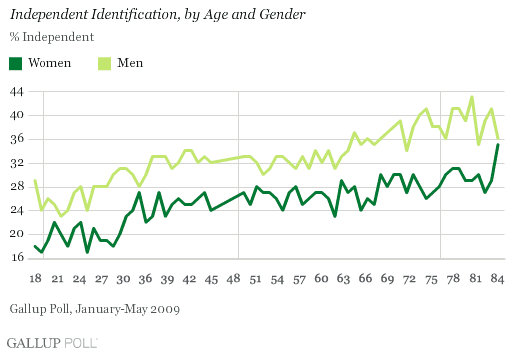
Racial and Ethnic Groups
There are well-known and significant differences in the patterns of partisan identification across major racial and ethnic groups. Blacks and Asians are more Democratic in orientation than are whites (blacks, much more so). But within each of these three groups, women are more Democratic than men.
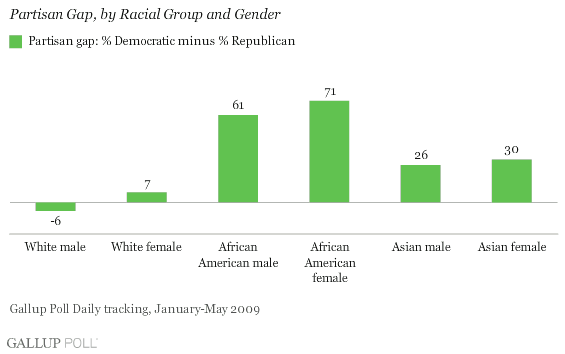
Overall, Hispanics (of any race) are more Democratic than non-Hispanics. But Hispanic women are more Democratic in orientation than Hispanic men, and non-Hispanic women are more Democratic than non-Hispanic men.
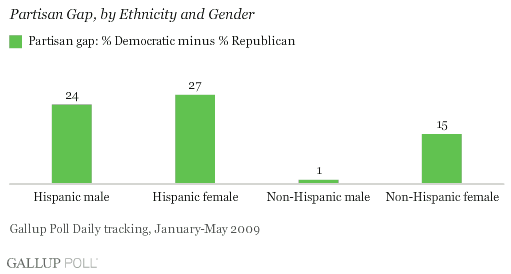
Marital Status
There are also significant differences in Democratic orientation within segments of Americans based on their marital status. In general, Americans who are living with a domestic partner, those who are separated but not divorced, and those who are single are more Democratic than others. Married Americans are the least likely to be Democrats. But, as was the case for racial and ethnic groups, the data show a gender gap within each of these groups. Single women are more Democratic than single men, married women are more Democratic than married men, divorced women are more Democratic than divorced men, and so forth.
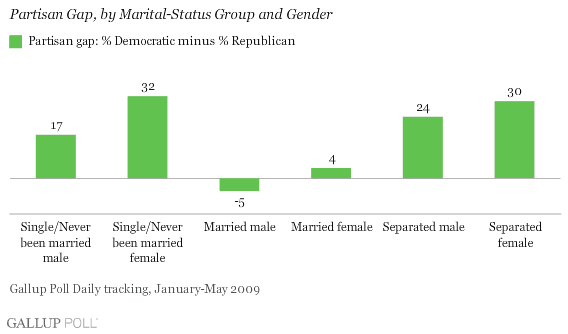
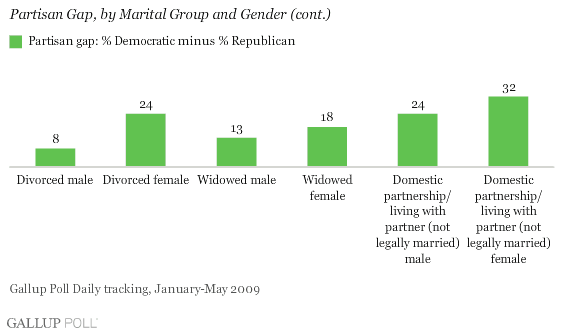
Implications
Although the existence of a gender gap in American politics has been well established, the very large sample sizes available with Gallup Poll Daily tracking allow for a more-detailed-than-normal examination of the nature of gender differences. The remarkable finding is that women of all ages are more Democratic in orientation than are men of the same ages, and that women of all ages are also less likely than men of the same ages to be independent. (The differences by age in the percentage identifying as Republican are much smaller.)
This means that whatever forces are at work that determine party identification in America today -- socialization, cultural patterns, social position, social status, and life orientation -- are already in place by the time young men and women reach the age of 18. And, these same patterns seem to have affected or are currently affecting men and women in their 80s in a similar fashion. The fact that the gender gap persists not only across age groups, but within major racial, ethnic, and marital-status groups reinforces the conclusion that a gender difference in political orientation is a fundamental part of today's American political and social scene.
Survey Methods
Results are based on telephone interviews with 149,192 national adults, aged 18 and older, conducted Jan. 2-May 31, 2009, as part of Gallup Poll Daily tracking. For results based on the total sample of national adults, one can say with 95% confidence that the maximum margin of sampling error is ±1 percentage points.
Interviews are conducted with respondents on land-line telephones (for respondents with a land-line telephone) and cellular phones (for respondents who are cell-phone only).
In addition to sampling error, question wording and practical difficulties in conducting surveys can introduce error or bias into the findings of public opinion polls.
